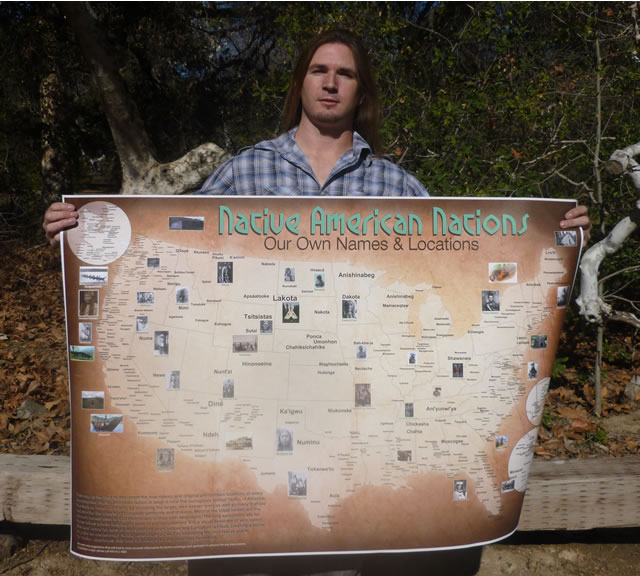 |
Canku Ota
|
 |
|
(Many Paths)
|
||
|
An Online Newsletter
Celebrating Native America
|
||
|
June 2013 - Volume 11
Number 6
|
||
|
|
||
|
Tribal Nations Map
Released
|
||
|
by press release
|
||
|
May 18th, 2013…..Warner, Oklahoma (within Cherokee Nation
jurisdiction) We officially announce the release of the first-ever, newly-copy-written Tribal Nations Map: I grew up knowing about my Cherokee heritage. My maternal grandparents are both mixed-blood Cherokees from Oklahoma. They would tell me, “You are part Native American, and you should know about it.” At 6 years old my grandpa gave me a Scholastic book called Custer and Crazy Horse. Reading that book solidified in me an understanding of the injustice that had happened to tribes in this country. It was the start to the eventual path I was led on. I went from reading Native books, to attending Powwows, to getting involved in local tribal meetings and concerns, to joining the American Indian Movement of Southern California. It also led to the creation of the Tribal Nations Map. As a young kid, I had always sought more knowledge about Native history and cultures. I would attend Pow Wows and scour through the items vendors had for sell. From time to time I would see maps of the traditional territories of our tribes, but thought they looked incomplete, and the names mostly inaccurate. I filed away the idea of one day creating a more authentic-looking one myself. Years went by as I looked from time to time for a better map. One day I decided, "It’s time to make a REAL map of Native America, as WE see it." It started with four poster boards and a rough pencil drawing of the United States. Over the next 14 years I would create the Tribal Nations Map. I spent countless thousands of hours poring through books, investigating in library archive buildings, making phone calls and traveling to remote reservations in the spirit of creating the most thorough map of Native America in existence. I have many stories of difficulties tracking down tribal members who could tell me their tribe’s real name. Many of these told me that they were some of the last speakers of their tribal language, or one of the only ones who knew the translation of the name. My intention for the Tribal Nations Map is for it to replace existing maps that are lacking in substance. Many maps of tribes in the United States only contain the names of 50 to 100 tribes, and many times utilize the incorrect names imposed on them by outsiders. My intention is also to instill pride in our Native American people, especially the youth. I also want people to understand that this entire country was covered with tribes. There is a myth that only small sections of the United States were populated before the coming of the Europeans. That is completely inaccurate. I have sold them to universities, museums, tribal offices and individuals. I hope to continue spreading them throughout Indian Country as well as the dominant society, to educate people of our true history. Once I completed the research for the map, I them decided to use a free map-making software program called Inkscape . There I uploaded an outline of the United States, and starting inputting tribes one by one. I added historical pictures of Native Americans from a variety of tribes, to show just how diverse our nation’s style of dress and appearance are. I also added pictures of different tribal dwellings. I then took this program to a graphic designer in Flagstaff, Arizona – Overdrive Media and Printing- and had them help me with a background template, color and layout. We also decided on a standard size for the map at 35 by 52 inches. Smaller versions will soon be available, but because there are almost 600 names on the map, a larger size displays them better. I published and copywrote my map independently through the US Copyright Office. I was assured that it is the only map of its kind. The concept of a map documenting every tribe, using Native tribal names had not been copywritten up to this point.
THE CONCEPT OF THE TRIBAL NATIONS MAP
To purchase your own copy, or to see our website, please go
here : Contact : Aaron Carapella (949) 415-4981 or 949-973-3673 (available for interviews) |
|
|
||
|
|
||
| Canku Ota is a free Newsletter celebrating Native America, its traditions and accomplishments . We do not provide subscriber or visitor names to anyone. Some articles presented in Canku Ota may contain copyright material. We have received appropriate permissions for republishing any articles. Material appearing here is distributed without profit or monetary gain to those who have expressed an interest. This is in accordance with Title 17 U.S.C. Section 107. | ||
|
Canku Ota is a copyright ©
2000 - 2013 of Vicki Williams Barry and Paul Barry.
|
||
 |
 |
|
|
The "Canku
Ota - A Newsletter Celebrating Native America" web site and
its design is the
|
||
|
Copyright ©
1999 - 2013 of Paul C. Barry.
|
||
|
All Rights Reserved.
|
||
